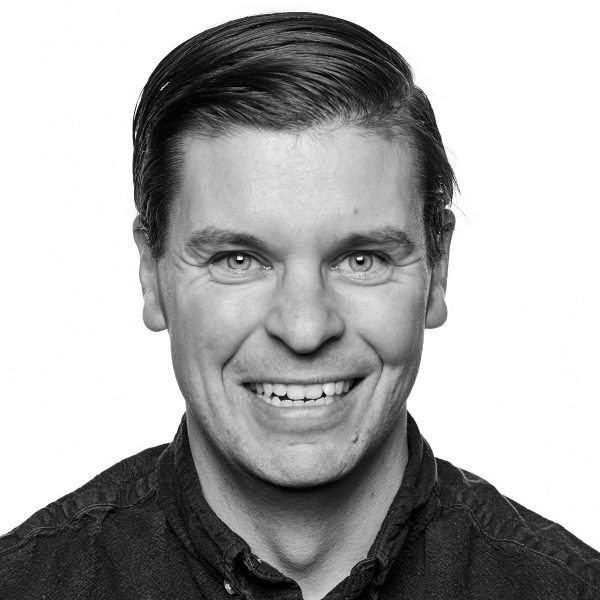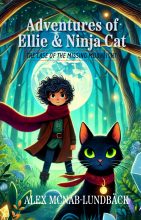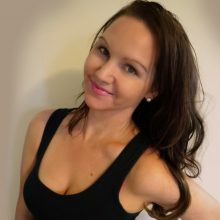The Adventures of Ellie & Ninja Cat by Alex McNab-Lundbäck
What led you into writing?
I think I’ve always been a storyteller in one sense or another. Even in infant school, I remember how i used to make up stories for my friends during break time, spinning little adventures on the playground. I think i craved the attention, but I also loved creating worlds, seeing their reactions, and feeling the magic of a well-told tale.
As I got older, that love for storytelling evolved. I started writing poetry, exploring the rhythm and weight of words. I was fascinated by how a simple phrase could evoke emotion, transport someone, or spark imagination.
But as a child, and even now, my deepest love was always for classic fantasy and adventure stories. The Chronicles of Narnia, Alice in Wonderland, The Wizard of Oz. Those books shaped the way I saw stories. They were doors to other worlds, pure escapism… filled with wonder, mystery, and characters who made you believe in the impossible.
Writing, for me, has always (although I’m relatively new to fiction), has been about that – building worlds, exploring ideas, and doing my best to put my spin on, and capture the magic that made me fall in love with stories in the first place.
How does a typical day look?
A typical day for me is filled with words – funnily enough. Whether I’m writing for others or for myself.
My morning starts early (usually awake by 5:30) and then into the school run, and by 8:30, I’m back home, coffee in hand (third cup by then), and straight to my desk. My day job as a ghostwriter and communications coach means I spend a lot of time crafting speeches, articles, and blog posts for clients. It’s intense, but I love the challenge of shaping ideas into compelling ‘stories’.
There are occasional meetings, but for the most part, I’m writing. And in between all that, I try my best to carve out moments for my own fiction. Some days, it’s structured writing sessions; other days, it’s grabbing whatever time I can to refine ideas, map out plots, or push forward on a draft.
By 3pm, I switch gears back to ‘Dad mode’ – school pickups, homework, family time. Evenings are where I squeeze in more writing if I can, or simply unwinding. Writing fiction is something I have to make space for amidst everything else, but it’s always there, pulling me back, no matter how full the day is.
In what ways do your characters test your abilities?
My characters always test me because they feel real (even if they are not of course!) – but this is probably because nearly all of them are inspired by people I’ve met, worked with, or even lived with. That means I have a responsibility to get them right – not just in how they speak or act, but in making sure they feel like fully formed individuals with their own thoughts, flaws, and desires.
Ellie, the protagonist of The Adventures of Ellie & Ninja Cat, is a great example. She’s lightly inspired by my own daughter, (also named Ellie), but I always stress that the two are not the same person! The Ellie in my book is her own character. She is shaped by the themes of the story, the world she explores, and the challenges she faces. And yet, there’s an undeniable connection. Writing her means balancing familiarity with fiction, making sure she isn’t just a reflection of real life but a character readers can ‘see themselves in’.
The biggest test, though, comes when my characters surprise me. I might have a clear idea of where they’re headed, but as I write, they push back. They make unexpected choices, reveal layers I hadn’t planned. And that’s when the real challenge begins -i think – following where they lead, even if it means rewriting, rethinking, and stretching my abilities as a writer.
What’s your setup?
I don’t really have a fixed setup as such actually. Not at the moment at least. When my wife is not working at home, I can use the study which is a fairly messy room but at least it has my monitors and is a separate ‘space’. Otherwise I’m writing at the Kitchen table, or my favourite armchair in the lounge.
What lasting effects have your favourite authors had on your writing and style?
The authors I loved growing up have definitely shaped my love of stories – and definitely how I write them!
C.S. Lewis, L. Frank Baum, and Lewis Carroll taught me the power of descriptions and ‘wonder’. The Chronicles of Narnia, The Wizard of Oz, and Alice in Wonderland were back as a kid, more like invitations to step into strange, magical worlds where the impossible felt real. That sense of adventure, of crossing into something bigger than yourself, is something I try to bring into my own work.
At the same time, I’ve always been drawn to the way some writers use language. How every word matters. Poets like Seamus Heaney and novelists like Neil Gaiman taught me that writing doesn’t just tell a story; it has a rhythm, a pulse. I want my writing to feel alive, whether I’m crafting a fantasy adventure or a piece of ghostwriting for a client. That has got to come from my early writing of Poetry which of course does just that.
But there is of course also a much deeper impact, and that’s how these authors make you feel. The best stories stay with you because they CONNECT to something real. I think that is what I am trying to aim for. I want readers to be drawn into my worlds, to feel a sense of wonder, but also to recognise something true within them. If I can capture even a fraction of what my favourite authors did for me, then maybe I’m on the right track.
What do you do for inspiration?
For me, inspiration comes from movement.
I walk a lot for sure. Sometimes just to clear my head and relax, but often to let ideas take shape. Twice a week, I walk my neighbour’s dog, which is honestly one of the best things I do for my creativity. There’s something about being outside, away from a screen, that sparks new ideas. I’m lucky to be surrounded by incredible forests, and they’ve become a huge source of inspiration, especially for world-building. The way light filters through the trees, the shifting seasons, the sounds of the wind and wildlife – it all feeds into the stories I create.
Running does the same thing. When I run, my mind wanders, and before I know it, I’ve plotted out an entire scene or figured out how to fix a tricky part of a story.
Lately, I’ve started capturing more of these moments as well by taking videos and photos, and sometimes dictation. Not just for visuals, but for the sounds, the small details that can bring a world to life. Writing isn’t just about what you see; it’s about how a place feels. So whether I’m walking, running, or just paying closer attention, I try to absorb as much as I can – because you never know when something seemingly small will turn into the next big idea.
What repeating themes do you find yourself pulling into your stories?
Certain themes always seem to find their way into my stories, whether I intend them to or not.
Time seems to be a big one – how it moves, how we interact with it, and what it means to shape our own future. My upcoming ‘The Timekeepers’ trilogy is built entirely around this idea, exploring the tension between free will and destiny, memory and forgetting. But even in The Adventures of Ellie & Ninja Cat, time plays a role in more subtle ways – through choices, consequences, and the idea that the past isn’t necessarily as fixed as we think, or that we can change the future if we act now.
Another recurring theme is identity and belonging. My protagonists often find themselves in worlds where they don’t quite fit – at least not at first. Whether it’s Ellie stepping into a world she doesn’t understand or Nils questioning his place among the Timekeepers, my characters are always searching for who they are and what role they’re meant to play. I think this is very self-reflective, as I often wonder (and certainly did as a kid), where my place was. Did I fit or belong in this world?
And then there’s the power of stories themselves. I’ve always been fascinated by the way stories shape us, the way myths and legends hold truth, even when they’re wrapped in fiction. My books often have characters uncovering lost histories, forgotten truths, or stories that change the way they see the world.
Ultimately, I think these themes come from my own experiences – the idea that we’re all shaped by time, by the stories we tell ourselves, and by the search for where we truly belong. In this way, we can all find some relation to the stories I tell or the poems I write.
How do you wind down?
Winding down isn’t always easy when my mind is constantly ticking with ideas, but I have a few things that help.
I spend so much time writing that it’s easy to forget to just enjoy stories. So I recently have made a point of making more time to read (or listen to audiobooks) – sometimes fantasy, sometimes historical fiction, sometimes something completely unexpected. It helps me switch gears and reminds me why I love storytelling in the first place.
Walking and/ or running and exercise is another go-to. I walk my neighbour’s dog twice a week, and that’s not just great for inspiration – it’s also a way to reset, to be present in the moment rather than caught up in a story or a deadline. Running helps, too. It’s one of the few times my mind can drift without distraction, which, ironically, sometimes leads to even more ideas.
And then there’s family. Evenings are about spending time with my kids, cooking, gaming with the kids, and just being Dad rather than a writer.
What sort of challenges do you regularly overcome while designing your world/setting?
World-building is one of my favourite parts of writing, but it comes with its own set of challenges, and I think the biggest one is balancing depth with storytelling.
So one of the biggest struggles is knowing when to stop. I love crafting intricate settings, pulling inspiration from folklore, history, and the landscapes around me. But it’s easy to get lost in the details…developing lore and tales, creating histories, drawing maps maybe – when, ultimately, the world needs to serve the story. I constantly remind myself that not everything needs to be explained upfront; sometimes, the best world-building is what’s implied rather than spelled out.
Another challenge is making a world feel lived-in. A setting isn’t just scenery, it has to breathe and also has to feel real (even if it is imaginary or fantastical). That means thinking beyond big-picture elements like magic systems or geography and considering the little details: how people speak, what they eat, what stories they tell. As I mentioned, recently, I’ve started taking more photos and videos while walking or running, capturing real-world details – how the light moves through the trees, the texture of things around me, the distant sound of birdsong. These small observations help ground the fantastical elements of my worlds in something real that readers can relate to.
Finally, there’s the challenge of consistency. In a series like The Timekeepers or Ellie & Ninja Cat, where time itself plays a central role, small inconsistencies can unravel everything. I try and rely on my notes, timelines, but sometimes just reading back through my own work obsessively to make sure the rules I’ve set actually hold up. It can get pretty chaotic though – i think when it coems to editing, this is the biggest challenge for me and the editor – keeping things making sense!
World-building is a balancing act. It needs enough detail to make it immersive, but not so much that it drowns the story. And every book teaches me something new about getting that balance right.
What are you reading at the moment?
I’ve got two on the go. Phillip Pullman’s Northern Lights, and this will lead to the other books in the series which I haven’t actually read yet (it’s my 2nd time reading Northern Lights). I’m also reading The Cruel Prince by Holly Black – which is actually my daughters book but I got so engrossed that I am nearly finished it before her. Both of these I love for their world building and descriptive imagery. I think Pullman is a huge influence on my work.
What’s the most useful advice you could give to an aspiring author?
The best advice I can give to an aspiring author is this: write before you’re ready.
Too many writers get stuck waiting – maybe waiting for the perfect idea, or the perfect opening sentence, the perfect time. But I think if you really want to enjoy the process, writing isn’t about perfection. It’s about getting words on the page, even when they feel clumsy or incomplete. You can’t edit a blank page, but you can shape and refine a messy first draft.
That’s exactly how The Adventures of Ellie & Ninja Cat started. I never intended to be a fiction author in 2025. But one day, my daughter made a little comic book in school, and it sparked something. I started drafting a story, just to see where it went. I kept pushing through, and eventually, I decided to publish it. That one decision – to just start writing my ‘silly little idea’, has led me down a path I hadn’t expected, not just in storytelling – but in learning about publishing, marketing, and how to bring a book into the world. None of that would have happened if I had waited until I felt “ready.”
Beyond that, here are three things that have helped me:
Finish something. Ideas are easy. Half-written drafts pile up. But finishing a story, whether it’s a short piece, a chapter, or an entire book, teaches you discipline, structure, and what it really takes to tell a story from start to finish.
Embrace rewriting. The first draft is never the best draft. Writing is rewriting – refining, cutting, reshaping. I think this can be the most fun also – it’s when the magic happens – in the edits.
Read widely, but write your own way. Read everything – inside and outside your genre. Fiction and Non-Fiction. See how other authors build worlds, shape dialogue, and pace their stories. But don’t get lost trying to sound like someone else. Find your own voice.
Most of all, don’t overthink it. Write. Keep writing. And enjoy the process, because that’s what keeps you going in the long run! 🙂
Tell us about the book you’re promoting.
I’m really excited to be promoting The Adventures of Ellie & Ninja Cat, the first book in what will be a full trilogy of magical adventures.
At its heart, the story follows Ellie, a curious and determined 10-year-old, who notices something strange – the moonlight is fading (or faded). When she follows her new companion, a mysterious black cat, named ‘Ninja Cat’, into an enchanted forest, she stumbles into a hidden world where the Queen of Light has stolen the moon’s glow to save her kingdom, causing a dangerous imbalance.
Ellie must race against time to restore the moon’s power before both worlds fall into darkness.
The book is filled with magic, mystery, and adventure, but it’s also about bravery, trust, and finding your own way – even when the path isn’t clear.
This is just the beginning of Ellie’s journey. I’m really happy to reveal as an exclusive on here, that The Ellie & Ninja Cat Trilogy will continue with ‘The Clockwork Labyrinth’, where Ellie unravels the secrets of lost history, and conclude with The Lantern of Hidden Doors, where she begins to see glimpses of something, or someone, she never expected. All three will be released this year.
While Ellie & Ninja Cat is about adventure for slightly younger readers and audience, The Timekeepers explores the cost of rewriting history, the power of memory, and whether the past can truly be changed.
Both series are connected in ways I can’t wait for readers to discover. But for now, it all starts with The Adventures of Ellie & Ninja Cat.
👋 Hi! I run Author Interviews
As a new writer I found myself itching to contribute to a thriving, creative community, so I made Author Interviews and I've met loads of wonderful people in the process. You can buy my debut fantasy RINGLANDER: THE PATH AND THE WAY from Amazon.





